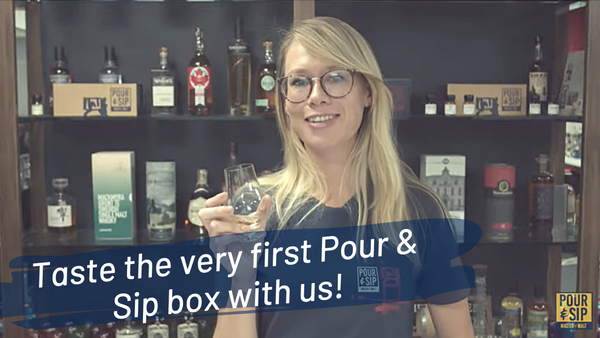The Deanston low-down with master blender Julieann Fernandez!

March is coming to an end, so it’s time to round off our Women in Whisky-themed box with a chat with Deanston master blender, Julieann Fernandez. We talk fermentation fun, sustainable practices, and all her positive experiences being a woman in the whisky industry!
Pour & Sip: Hi, Julieann! Let’s start with an overview of the history of Deanston…
Julieann Fernandez: Deanston Distillery is quite unique. It’s an absolutely beautiful distillery. It used to be a cotton mill and that’s where our story begins. Around 1785 it opened as Deanston Cotton Mill, and the mill was right at the heart of the community. It provided employment to around 1,500 people, and formed a kind of self-contained little village. It had houses in it, grocers, a little school. They even had their own currency. It was really the heart of the community, and I think you still see that at Deanston. A lot of the operators that we have working at Deanston, they all live in the local area and their fathers and grandfathers all worked in the distillery. But changing times meant that the cotton mill had to close and in 1965 the mill was turned into Deanston Distillery.
Deanston sits right on the banks of the River Teith, which is the second-fastest flowing river in Scotland. It had big water wheels, so it’s always been powered by sustainable energy. The water from the river was absolutely perfect not only for that, but it flows over granite. It’s beautifully soft, beautifully clear. That means that it creates the perfect water for us to use in the distillery. And not only that, the weaving shed, where they weaved the cotton, wasn’t temperature controlled, because you’re going back so many years. The way it was built, it had vaulted ceilings and there was grass on the roof, and that maintained a temperature for the cotton. Now we use that as one of our maturation warehouses – it’s just absolutely perfect for maturing whisky because there’s not much of a temperature gradient, so the whisky matures really evenly. The distillery’s beautiful, it’s got a lot of history. It stays true to its heritage, it still looks like a cotton mill from the outside.
P&S: Wow! So it’s always been run on renewable energy?
JF: Yeah, that’s right. Back in the day when it was a cotton mill, they had the huge water wheels that were powered by the water coming from the Teith. We’ve obviously had to make a few upgrades to that, but we still generate all of our own electricity that we use in the distillery, and we actually generate so much that we give back to the grid as well. We were quite fortunate that we adopted that as part of the distillery, it’s the absolute perfect setting.
P&S: Water seems like a really important part of the distillery – does it also affect the final taste of the whisky?
JF: So you’ve got a few different influences. If you look at Islay, the majority of the distilleries there, the water flows over peat, so they get that kind of peaty influence in their whiskies. At Bunnahabhain we pipe the water in, so we actually don’t go over peat at all, so that really affects the process. It’s the exact same at Deanston. The water’s flowing over granite, which makes it really, really soft. All the water that we use for our distillation, processing – all of it comes straight from the River Teith. That really, soft, clear, beautiful drinking water performs really well. The water is just so pure, it’s not adding any taints or flavours during the process. It’s just complementing what we’re doing with our malts and how we’re making the whisky. I definitely think if we changed the water supply, it would make a difference to what we do in the distillery.
P&S: Deanston has this famed, waxy new make – how does that come about?
JF: The stills in Deanston Distillery are really, really tall, and they have an inclining lyne pipe. Because of that and the shape of the stills, when we’re distilling it generates a lot of reflux. Then with the reflux obviously the whisky’s going to like boiling up, and it’s not quite managing to get over because that inclining lyne pipe almost pushes it back. So it’s really working so hard to get up. Because of the amount of reflux that we’ve got, and the still, it means that we get quite a light spirit. But at the same time, we’re getting a lot of these fats forming that give us that beautiful waxy character that you’re talking about. It’s really unique as a new make spirit, and it’s absolutely perfect for what we do with Deanston.
P&S: Onto the 18 Year Old! Talk us through the expression?
JF: As I said, we mature most of our core range for Deanston at the distillery, so it’s fortunate that the 18 Year Old spends its life in that beautiful weaving shed, so it gets a really even maturation. But before we even hit maturation, at the distillery we’re 5 / 3 production, which means we have a range of long and short fermentations – the reason for that being that the guys are working Monday to Friday. But you can’t tell yeast at 5 o’clock on a Friday that it’s time to clock off! That yeast continues to work right over the weekend. So the long and short fermentations are giving us all the different characters that you’ll see coming through in Deanston. A lot are nutty and spicy, and then as the fermentation gets a little bit longer, you gradually go through to your freshly cut grass, hay, and right through to your fruity notes. What we do is blend the spirit that we distil from that, so that we get the perfect balance of the longs and shorts. And then with the reflux on the stills, you’re getting that beautiful light spirit with quite a lot of crisp apple, and that unique waxy character as well. Our 18 Year Old spends 16 years maturing in refill oak barrels, and then for the last two years of its life it goes into bourbon casks. The way that we look at it is, obviously it’s an 18-year-old, but really it’s a kind of 16-plus-2. Those 16 years, the whisky’s just resting and doing what it does, the refill casks don’t really do too much to the whisky. We’ve got so many beautiful flavours and characters coming through from the new make spirit, we don’t feel that we need to alter it all that much. From there we put it into the bourbon barrels and that just rounds it off. After the two years it’s aromatic, but we’ve not lost the character of Deanston at all.
P&S: Two years is quite a long finishing period, too!
JF: When I talk about finishes, I tend to base my finishing times on about two years because of the climate in Scotland. It’s not the warmest up here, so I do feel that most of our whiskies need about two years to take on the character that we’re looking for. Obviously it’s completely dependent on the cask. We’ve done some expressions before using beer casks for Deanston, and the finishing time was only between six to nine months, so it’s all about monitoring that. Deanston is an absolutely beautiful spirit, and all we want to do is complement it, we never ever want to mask it. Two years is the sweet spot to round it off a little bit, but not overpower the beautiful kind of honeyed, fruity profile that you already have at Deanston.
P&S: Deanston seems to stand up well to almost every cask type – it’s so versatile, considering it is such a delicate spirit.
JF: That’s what I absolutely love about the Deanston brand – it’s versatility. We’re so fortunate that no matter what cask we put it into, it just seems to have worked. For that reason I would say out of the three brands we have at Distell, Deanston is our most versatile and expressive. We’re fortunate that we have an experimental cask budget, and I’d say that the majority of the experimental casks will go mainly on Deanston. It’s so adaptable, it lends itself so well to so many different finishes, whether that is stout casks, or the Pinot Noir finish we just released as well.
P&S: Let’s hear about you! How did you get into the industry?
JF: Between my third and fourth year at uni I decided to do a placement year. I’d applied for a few different things and I ended up working with Chivas Brothers in their lab, doing analytical chemistry work. It was there that I started doing some work for their sensory panel and doing the organoleptic work on the spirit. I realised that that was the side of things that really interested me. Then I went back and finished my degree, and after I graduated I worked with the Scotch Whisky Research Institute, who do absolutely phenomenal work for Scotch whisky. I was doing analytical work with them, and again, I was part of the sensory panel there, and I really, really enjoyed it.
Then an opportunity came up to join Chivas again, so I decided to jump back there. I was working in their grain distillery. That really gave me a kind of insight as to how grain whisky is made. I think that some people focus on the malt and we forget about the grain – but especially as a blender, you need to understand that process and the different flavours that the grain brings to your blends. I was able to spend some time at their malt distilleries as well and I suppose it was from there that I realised I had that passion for whisky, and that it was the organoleptic stuff that I really enjoyed, rather than just being in the lab. When the opportunity came up to join Distell – I think that was in 2017 – I moved over there as a blender. I suppose that’s where my career really started in the whisky industry. With Distell not being a huge company, you’re very fortunate that you get to be involved in so many different parts, and exposed to so many areas of the business that you might not be in larger organisations. At the tail end of 2019 I was promoted to master blender and I absolutely love it. Every day is just so different. One day it’s nosing new make spirit and assisting the distilleries with quality issues that they’re having; the next day could be trying to work out a five-year plan for the limited-editions and purchasing casks, tasting samples, doing master classes. It’s been a journey, but one that I’ve thoroughly enjoyed.
P&S: Did you drink whisky before that journey?
JF: No, it was completely not on my radar. I’ve always been a red wine drinker, so that’s my go-to. I suppose it’s a bit like anything, you almost learn to appreciate it. I don’t know if that misconception that people have about whisky being for older people, maybe for that reason I didn’t really drink it. My mum doesn’t drink it all because she associated it with her dad going to the pub with his friends. She thought that’s just what old men do. Obviously once I started in the industry I started to understand whisky and appreciate it more.
P&S: How have you found being a woman in an industry that is in part male dominated, and also assumed to be male dominated as well?
JF: I think you’re right on what you’re saying there about it being assumed to be male dominated. I think sometimes what people are looking at is the positions that the males have – and don’t get me wrong, there’s a lot of them in senior positions – but there’s equally as many females in senior positions these days. You’re really seeing females starting to come up through the ranks. It’s not just that though, it’s maybe that these positions are more seen, but behind the scenes – all the work that goes on in labs, customer service work, marketing – there are actually strong female-forward positions. Especially if you look at our marketing team, our brand managers are females and we’ve got a lot of females working with us at Distell, which is great. Even working at Chivas, I joined one of their sites where there was only one other female on-site and it didn’t feel strange or different at all. This is a site that’s in the heart of Glasgow with guys that have been in this industry for years – honestly, they couldn’t have made me more welcome. I think being thrown into situations like that have made me stronger as a person, and if it wasn’t for being put in these positions then maybe I wouldn’t have got to where I am today. I’ve been really fortunate that the males I’ve worked with have been so supportive. Being in this position now as a female and being a little bit younger, I’m just so fortunate that I’ve really not faced any form of discrimination in any way. I’m very grateful for that. I’ve got nothing but praise for the males and females that I’ve worked with in the industry.
P&S: Is there anything in the Deanston pipeline that you can tell us about?
JF: Our limited-editions that we’ve got coming up are a closely guarded secret. What I can say is we’ve got our Deanston Organic, and we’re putting quite a focus on that just now. So you’re going to start to see more expressions of Deanston Organic coming out, and maybe something a little bit different with that. There aren’t many distilleries that are fortunate enough to produce organic whisky, and we’re lucky that we’re one of them. We do have some beautiful limited-editions that we’re getting ready to release, so I’m really looking forward for everybody to try them.
P&S: You’ve just got in from work and you fancy a dram – what’s your go-to?
JF: I think it just depends on what kind of mood you’re in! Because I work across three distilleries, they all bring something unique. What I would say about Deanston is it’s one of those drams that you can have at any time and you can turn that into whatever you want it to be. After a hard day at work, when you’re wanting to sit and relax, something like a Deanston Virgin Oak, or a Deanston 12 Year Old, is just perfect. You can have it neat, you can put a bit of ice in it, or you can mix it. Drink it however you want! There’s no right or wrong way to drink it, and I would hate for that to put somebody off drinking a whisky – that they feel that they need to drink it neat. Adding a few drops of water or a bit of a mixer might just make it that little bit more enjoyable. And as long as you’re enjoying it, that’s the main thing for me.
That’s a wrap for March! We loved sharing this month’s themed box with you – and it sounds like you loved it, too. April’s box will be flying through your letterboxes soon, and we can’t wait for you to try them…
Until next month!
Jess 🥃



